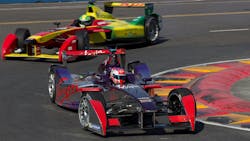Formula E's 2023 Season Ups the Stakes with 3rd-Gen Electric Racers
This article is part of the TechXchange: Formula E Racing.
What you’ll learn:
- How advances in technology have made these upstart all-electric racers nearly as fast as legendary Formula 1 racers.
- Why the third generation of Formula E racers is the first series that doesn't use any mechanical brakes.
- Which quirky feature of the competition appears to have been borrowed from a popular video game?
Now entering its 9th season of competition, the Formula E racing circuit is introducing a new generation of more advanced, faster electric vehicles that will battle for supremacy at speeds in excess of 200 mph.1 This year's schedule, which consists of 18 races held between January and July 2023 on street circuits in 13 of the world's leading cities, is testing the cars' technologies in a wide range of grueling real-world environments.
The first generation of Formula E cars were the pinnacle of EV technology when they hit the track in 2014, sporting a 200-kW (230 kW peak) motor from McLaren Electronic systems and a 28-kWh Li-ion battery from Williams Advanced Engineering that could propel the car from 0 to 100 mph in three seconds and achieve top speeds of over 170 mph. Gen 3 not only greatly exceeds these parameters, but also introduces many other advances in mechanical, electronic, and propulsion systems design that give them capabilities rivaling their fossil-fuel-burning counterparts.
To begin with, Gen 3 Formula E vehicles pack much more power than their predecessors. This new breed of e-racers is also the first-ever formula car to have front and rear powertrains.
Powertrains and Regenerative Braking
The primary powertrain delivers up to 350 kW (470 bhp) worth of propulsion and regenerative braking to the rear wheels. A second powertrain on the front wheels provides an additional 250 kW (335 bhp) worth of regenerative braking. However, it’s currently not configured to provide any propulsion to the 760 kg (1,675.5 lb.) chassis.
The racer's energy storage is handled by a 54-kWh battery (51 kWh usable) built by Williams, which weighs 223 lbs. less than its Gen 2 successor. 2 The liquid-cooled power pack is capable of recharging at rates of up to 600 kW, almost twice the rate available from the most advanced commercial chargers, enabling it to take full advantage of the dual-motor regenerative-braking system's output. It can also take on up to 4 kWh worth of charge during a 30-second pit stop.
Equally important, the cars' four-wheel traction systems allow them to hold higher speeds while navigating the twisty streets of cities like Monaco, Hyderabad, Berlin, and Portland. In addition, its four-wheel regenerative-braking capabilities completely eliminate the need for conventional mechanical brakes, making it the first formula car to not have any hydraulic brakes on board. In fact, the energy recovered by a regenerative-braking system augments the car's range by providing up to 40% of the energy used in a race.
Closing the Horsepower Gap
Though the Formula E class's all-wheel-drive, 800-bhp drivetrain still falls short of the F1 series' rear-wheel drive 1.6-liter hybrid gas/electric powertrain that produces roughly 1000 bhp, the performance gap has narrowed considerably. While F1 cars can hit speeds of around 230 mph (370 kph), the FE's dual-motor all-electric drivetrains can propel their vehicles to over 200 mph/322 kph. F1 cars are still quicker from 0 to 60 mph at around 2.6 seconds, but Gen 3 Formula E cars have narrowed the gap to slightly under 2.8 seconds.
In addition, the dual-motor electric drive and its regenerative-braking system enables the driver to make the most of the car's available power by distributing it across all four wheels as needed. They use computer algorithms that can be optimized to match track conditions.
While many variables are involved, a reasonably accurate comparison can be made from looking at the two types' performance at Monaco, the only circuit on which both cars race. For that track, the all-time lap record in an F1 car happened in 2019 with Lewis Hamilton clocking in at 1:10.166, while the fastest qualifying lap in Formula E in 2023 was Sascha Fenestraz’s 1:28.773.
Another more quirky difference is that Formula E tracks feature "Attack Mode" sections. These parts of the track are "interactive," where much like a video game, the racer can drive over to electronically unlock extra power from the vehicle. The catch is that the driver does have to take a longer route through the corner to activate the feature.3
These and several other technical advances have helped make Formula E racing nearly as fast as the Formula 1 series it was spawned from. To learn more about the cars, and where you can see them in action, visit https://www.fiaformulae.com/en. The next event, scheduled for June 24, will be held in the U.S. at Oregon's Portland International Raceway.
Read more articles in the TechXchange: Formula E Racing.
References
1. “Gen1 To Gen3: The Evolution of EVs In Formula E,” FIA Formula E News, Sept 29, 2022.
2. “Formula E Is Testing Its Lightning Fast Charging Pit Stops,” Chris Rosales, The Drive, Sept. 17, 2022.
3. “What Is Formula E, and How Is It Different From Formula 1?,” Alex Ramos, Make Use Of, April 23, 2023.
About the Author
Lee Goldberg
Contributing Editor
Lee Goldberg is a self-identified “Recovering Engineer,” Maker/Hacker, Green-Tech Maven, Aviator, Gadfly, and Geek Dad. He spent the first 18 years of his career helping design microprocessors, embedded systems, renewable energy applications, and the occasional interplanetary spacecraft. After trading his ‘scope and soldering iron for a keyboard and a second career as a tech journalist, he’s spent the next two decades at several print and online engineering publications.
Lee’s current focus is power electronics, especially the technologies involved with energy efficiency, energy management, and renewable energy. This dovetails with his coverage of sustainable technologies and various environmental and social issues within the engineering community that he began in 1996. Lee also covers 3D printers, open-source hardware, and other Maker/Hacker technologies.
Lee holds a BSEE in Electrical Engineering from Thomas Edison College, and participated in a colloquium on technology, society, and the environment at Goddard College’s Institute for Social Ecology. His book, “Green Electronics/Green Bottom Line - A Commonsense Guide To Environmentally Responsible Engineering and Management,” was published by Newnes Press.
Lee, his wife Catherine, and his daughter Anwyn currently reside in the outskirts of Princeton N.J., where they masquerade as a typical suburban family.
Lee also writes the regular PowerBites series.



